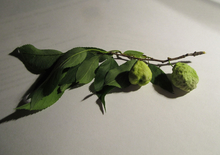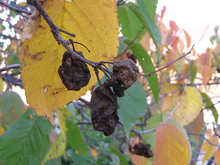Quick facts
- Plum pocket or bladder plum is an unusual disease that causes unripe plums to grow abnormally large within a month or two after bloom.
- Plum pocket is caused by the fungus Taphrina communis.
- Manage this disease by removing infected plums from trees before they produce spores.
How to identify plum pocket
Symptoms
- The infection starts with a small blister on the fruit.
- This blister quickly grows and soon covers the entire fruit.
- Infected fruit may grow to ten times their normal size and have a spongy texture.
- Fruit becomes covered with velvety, gray fungal spores.
- Eventually infected fruit dry out and turn black.
- If cut open, the center of these affected plums is empty.
- The fungus can cause the leaves to thicken and curl, but this is not common.
Brown plum pocket Infected fruit usually fall to the ground, but some will stay on the tree through winter.
- In many trees only a small number of fruit are infected.
Trees affected by plum pocket
- Plum pocket mostly infects wild plums and American type plums.
- Most of the dessert plums grown in Minnesota are unlikely to be affected by plum pocket.
How to manage plum pocket
Plum pocket does not affect the health of the tree and no management is necessary.
- The disease can be reduced by removing infected plums before they are covered with spores.
- Infected fruit should be buried in a compost pile.
Fungicides
If plum pocket has destroyed most of the fruit for several years in a row, fungicides can be applied before bloom to manage the disease.
- Plum pockets can be prevented with a single fungicide application just before bud break in early spring.
- Bordeaux mixture (copper sulfate), liquid lime sulfur or chlorothalonil can all be used to manage plum pockets.
Use Fungicides safely
The name of the plant being treated MUST BE LISTED on the fungicide label or the product cannot be used! Some products are registered for use on ornamental Prunus species but are not safe to use on stone fruit that will be eaten. Always completely read and follow all instructions on the fungicide label.
Post-harvest interval is important
Take care to wait the complete 'post-harvest interval' (PHI) listed on the label. The PHI is the number of days you must wait after applying a fungicide before harvest is allowed. This time period allows fungicide residue to break down to a safe level.
CAUTION: Mention of a pesticide or use of a pesticide label is for educational purposes only. Always follow the pesticide label directions attached to the pesticide container you are using. Be sure that the plant you wish to treat is listed on the label of the pesticide you intend to use. And observe the number of days between pesticide application and when you can harvest your crop. Remember, the label is the law.
Reviewed in 2024



